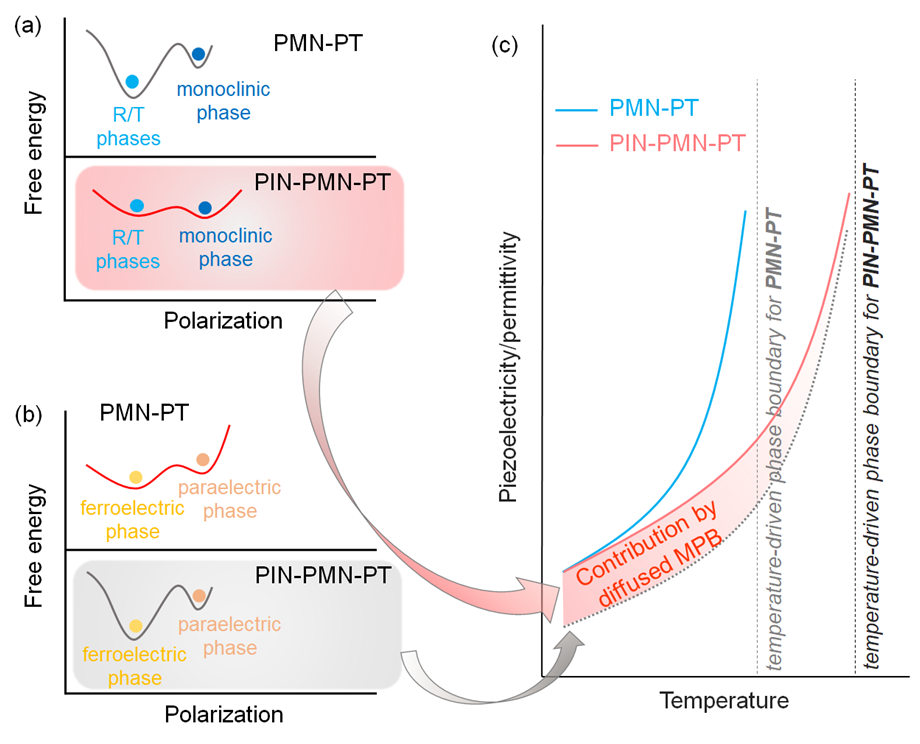New type of morphotropic phase boundary in ferroelectrics - Drs. Gang Liu andLingping Kong
MAY 7, 2020
New study led by Dr. Gang Liu from HPSTAR reported a new type of morphotropic phase boundary (MPB) in relaxor-PbTiO3 crystals. Such a novel MPB, referred as “diffused MPB”, results in both high piezoelectricity and thermal stability simultaneously, which is critical for the applications of ferroic materials. This work redefines the core concept in ferroelectrics, and opens a new way for future ferroic materials. The study is published in the flag journal of American Institute of America (AIP), Applied Physics Reviews, which is selected as a featured paper and is highlighted by Scilight which showcases the most interesting research across the physical sciences published in AIP Publishing Journals.
Improving solid solution ferroelectrics can lead to the development of new piezoelectric materials. Hoping to fully realize the potential of these materials, researchers are trying to expand their usage temperature, composition and field range while improving thermal stability.
New research led by Dr. Gang Liu from HPSTAR studied relaxor-PbTiO3 crystals to better understand the impact of morphotropic phase boundary (MPB) on the stability and piezoelectricity of the material. With a series of synchrotron measurements, they were able to resolve the fine structure of the material and further characterize its properties.
“Achieving thermal stability is essential to evaluate the application direction of materials. It is especially important if we need to use the materials at various temperature conditions,” said Dr. Gang Liu. “If a material has an improved thermal stability it will be more resistive to temperature variation, then the device made by it will have preferred performances.”
The team discovered a special morphotropic phase boundary linked to high piezoelectricity and increased thermal stability in MPB and Pb(In1/2Nb1/2)O3-Pb(Mg1/3Nb2/3)O3-PbTiO3 (PIN-PMN-PT) crystals named as a “diffused” MPB was unexpectedly wide, covering 9% of the PbTiO3 system. This resulted in high piezoelectricity and excellent thermal stability.
“We revealed that with appropriate materials-design, MPB can be broadened to a highly expansive composition-temperature region,” said Dr. Liu. “According to these results, we now understand when and why both high performance and great stability can be achieved simultaneously.”
Based on this research, the authors suggested that future piezoelectric materials design should consider the width of MPB. They expect that other ferroic systems, such as lead-free ferroelectrics, ferromagnetics, and multiferroics, may also benefit from “diffused” MPB.

Caption: Schematic mechanism of high piezoelectricity with improved thermal stability in PIN-PMN-PT.
对于铁电材料,高压电活性经常伴随着较低的相变温度和较窄的温度适用范围,极大程度限制了其进一步应用。因此,明晰上述现象背后的机制,进而发展出一条新的材料设计路线,将“鱼和熊掌”予以兼得,就成为了相关铁电材料领域关心的核心科学问题和长期目标。近日,北京高压科学研究中心刘罡研究员带领的科研团队首次通过超高分辨率的同步辐射X光衍射技术,对目前世界上压电活性最高的一类铁电材料——弛豫基钛酸铅单晶体做了细致的结构分析,进而阐明了材料中的复杂相界的产生机制,破解了相界的演化谜团。他们发现,通过合适的材料设计和掺杂,可以生成一种新型的相界。在相图上看,这种相界不再是通常意义上的一条或几条曲线,而是一个覆盖了相图上较大范围的多相共存面,具备显著的弥散特征。
